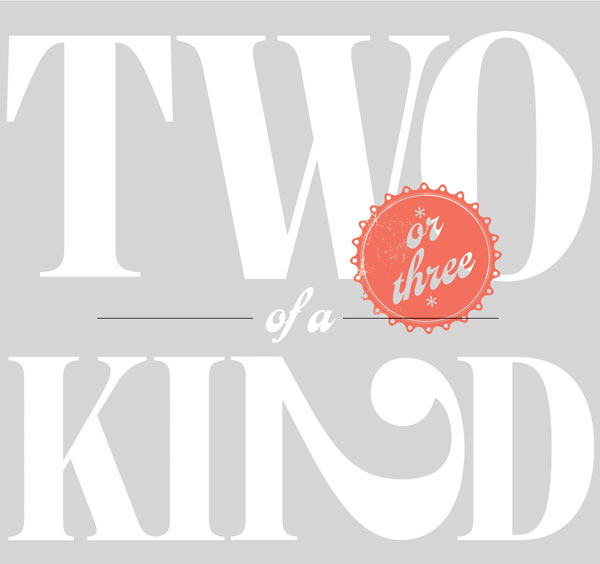
Mary Kate and Ashley Olsen made twinning cool in the ’90s. The Parent Trap had everyone hoping they’d find the other half of their dynamic duo someday at summer camp. But there’s more to twins than just identical and fraternal, and Hollywood has glamorized multiples to the extreme. There is a whole world of science behind twins and triplets beyond identical movie stars who switch places on their parents. Most of it happens before they’re even born, and when you factor in a third baby or a fourth, the differences become endless.
TEEN TWINS
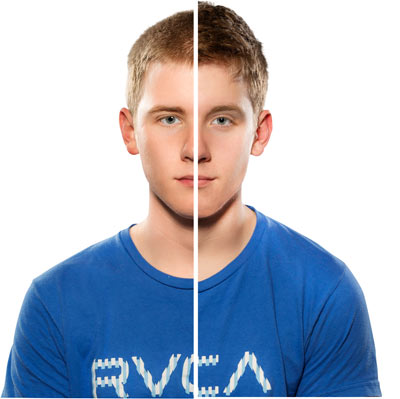
Josh and Jeremy Hartley, 17, can certainly relate. They’re mirror-image twins, which occurs in approximately 23 percent of identical twins when the egg splits seven or more days from conception. When the left and right sides become individual, their traits are reflections of each other’s. The most extreme cases reported describe one twin with all of his or her internal organs reversed from the normal order. In most cases, twins’ hair parts in opposite directions or their glasses prescriptions are reversed.
“I like telling people we were one person at one point,” says Jeremy, just one of the reasons he doesn’t mind a life of twinning. These laid-back boys have similar demeanors, walks and taste in clothes. Their reflected traits include opposite dominant hands and reflected birth marks on their foreheads. Each bore a birthmark on opposite legs when they were younger, too. But these brothers prove that twins aren’t clones—even their similarities highlight their differences.
“Josh’s interests are more athletic, and he used to play football. Jeremy is in ROTC. As a mom, I still see both of their demeanors as easygoing and laid back,” says their mother, Sheila. “The same subjects come easily to them both. They both have a bit of an artistic ability in drawing and playing the guitar. Jeremy loves to read fiction, and Josh likes to read nonfiction.” They aren’t huge fans of being considered mere reflections though, and mistaken identity isn’t uncommon.
“People ask him how my girlfriend is,” Josh laughs.
Jeremy says their teachers frequently mistake them for each other, too.
“You get associated with each other way too much, and the other one gets brought up in conversation all the time. I’ve had people actually call me ‘twin,’” he said.
For Josh, it’s being compared, sometimes right in front of each other, that he dislikes. The “twin telepathy” stereotype is one they face frequently as well.
“People ask me ‘Where’s Jeremy?’ I get sarcastic with it because it’s annoying. We’re at school; I don’t know where he is,” Jeremy jokes after miming a walkie-talkie to page his brother.
“When we were younger, if one of us had an idea or something you had to explain, the other one just knew. We’re not telepathic, but we think alike,” Jeremy explains. Sheila describes them as being similar to a married couple—they just get each other. Despite the cons, these mirrored brothers are grateful for their closeness in age and so is their mother.
“Even with our differences, we have an age relation,” says Josh.
“‘Hey, I have a twin brother.’ It’s like a built-in pickup line,” Jeremy jokes, thankful for his built-in wingman.
DOUBLE TROUBLE
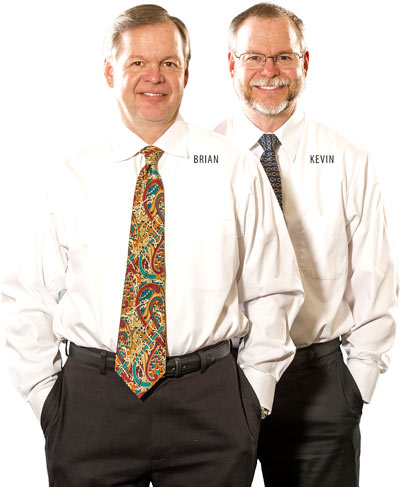
Brian and Kevin Stoothoff, age 53, are identical twin brothers. Brian serves as the assistant fire chief at the Ocala Fire Department, while Kevin works as a veterinarian. The two moved to Ocala with their parents after graduating high school, earned their AAs at the College of Central Florida and later graduated together from the University of Florida. Being together is just part of life for these twins.
“For the first 12 years of our lives, we had one bedroom that we shared. Having a twin gives you a constant companion to play with or fight with,” Brian says. “When we were very young, Mom and Dad would dress us exactly alike. Teachers couldn’t tell us apart. Today, I look back on some pictures when we were young and I have to think hard about who’s who.”
“My parents would ask who did it, and then we’d point at each other and we’d both get in trouble,” Kevin says of his double trouble childhood. “Half the time, they couldn’t tell who was who anyway.”
As for the twin connection made famous by Hollywood, Kevin reports something similar.
“I know as kids we felt each others’ emotions to a certain degree,” he explains. “I felt more of a bond with my brother. We relate to each other more than regular siblings might.
Of course, the brotherly matching gets old eventually.
“At some point you start to rebel a little and dress differently,” Brian explains. “We got jackets one year, and Kevin got a Yankees jacket, so of course I had to get a Mets one. I think now that we’ve gotten older people who know us can tell us apart easier.” Kevin says that isn’t the case when strangers are involved.
“People thought I worked at the fire department, too. A lot of people don’t think about us being twins though—they either know us as two different people or think we’re the same one. People would see one of us and not recognize the woman we’re with, not realizing we’re twins. They probably thought we were cheating on our spouses,” he jokes.
Just because these guys are identical doesn’t mean they have interchangeable personas.
“I think there are similarities and differences, too. As with all siblings, one of us is probably a little more conservative than the other,” Brian says with a smile. Both brothers note their strong work ethics as a major commonality, and Kevin added that although he is a vet and his brother is a paramedic, they both wound up in medical professions (as did their sister, a nurse).
Like many parents at the time, the Stoothoffs weren’t planning on multiples.
“I’m told my grandmother was a twin, but my parents weren’t expecting twins—that many years ago they had no way of determining multiple births. I was born first; my brother was born three minutes later, so I like to think I’m older but look younger,” says Brian with a smile.
The idea that multiple births run in the family is sibling legend. Fraternal twins can “run in the family” on the mother’s side alone if she inherits a gene for hyper ovulation, which is the tendency to release more than one egg when ovulating. This significantly increases the chances of conceiving twins.
BROTHER-SISTER BOND
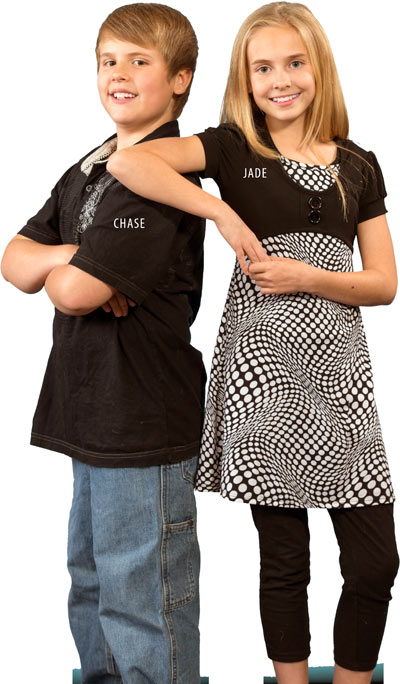
Of course, twins don’t have to be identical to be inseparable. Fraternal twins Jade and Chase Mallard, 11, just relocated to Citrus Springs with their parents, Jon and Angela, and sister, Charley, age 2. They’re enjoying having each others’ familiar faces around their new school according to Chase.
“We’re new to this school, so we sit together at lunch,” he explains. “We ride the bus, but we don’t have the same seats so if no one is sitting by her, I’ll go up and take it.”
When asked if having a twin was fun or occasionally annoying, Jade giggles and says, “Both, but it’s not fun if we go somewhere without each other.” Chase says he enjoys playing and riding bikes with his sister. The bad part? “If I do something, she knows.”
The Hollywood version of twintuition may be a farce, but the solid connection between these siblings is very real.
“I always hear ‘you can’t pick on my sister, only I can,’” says their father, who has appreciated their bond since day one.
“They keep each other company. They slept in the same crib when they were born—they held hands and always had to be touching each other,” he says. “They had their own little language growing up. Now they teach each other, and that really helps their grades.”
Jon makes a point of emphasizing their uniqueness, though.
“They’re fraternal, so they’re their own entities with their own ideas even though they are together all the time. Their personalities are totally different, but their caring quality is the same,” Jon says. “She was reading books over my shoulder by two, and he was doing math better than me by then. Chase is a little bigger with brown hair and brown eyes, and Jade has blonde hair, blue eyes and is petite.”
WORDS FROM A MOMO MOM
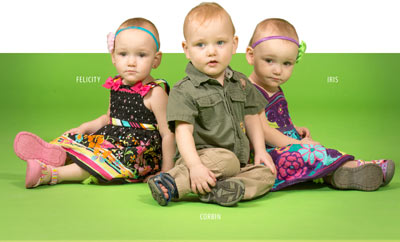
Though we’ve all heard that births of multiples run in the family, they also crop up in the realm of fertility treatments and in vitro fertilization. In IVF treatments, multiple fertilized embryos are returned to the mother’s uterus, increasing the likelihood that more than one baby develops. Doctors today recommend transferring only one or two embryos in order to prevent high-number births and the associated risks. When used too aggressively, ovulation-enhancing drugs can cause a woman to produce any number of eggs, leading anywhere from triplets to sextuplets.
Ocala resident Amanda Roos was a fertility patient when she conceived her triplets, identical girls, Iris and Felicity, and their fraternal brother, Corbin.
“As soon as I found out I was pregnant, I called the doctor because I was using Clomid, a fertility drug. It has a risk of less than 1 percent of having multiples,” she recalled. “They don’t do ultrasounds until 10 weeks, but I felt like something was going on and knew there had to be more than one. At 12 weeks, I had my first appointment at Shands, and they told me about the mono mono.”
Medical experts aren’t sure why monochorionic monoamniotic (MoMo) twins form, but they do know how. If the fertilized embryo splits after eight or more days, the placentas and amniotic sacs will be shared. This occurs in only 1 percent of twins. MoMo is usually detected before 14 weeks when placental structures are most visible. Naturally, babies sharing space face a unique set of risks, including cord entanglement, compression, premature birth or Twin-to-Twin Transfusion Syndrome (TTTS). They may also grow at different rates due to unequal access to the blood supply.
“The first research we did was scary because it goes from MoMo to conjoined, and there is hardly any info on triplets,” Amanda recalls. With a 40 percent mortality rate for the babies, expectant mothers are often transferred to a perinatologist for the duration of the pregnancy. Most moms enter the hospital after week 28 to be watched constantly.
“The girls shared the sac and the placenta, so the chances of dying from a cord accident were extremely high,” Amanda said. “I was in the hospital for eight weeks to keep the fetal heart rate monitors on them. If they stopped, they would do an emergency C-section. I did a lot of preparing for preemies since there was a chance they’d be delivered early. That was scary because it increased the chances of cerebral palsy and ventilation.” The girls shared their nutrition supply, so when labor came early at 30 weeks, one already had a half pound lead on her 2.5 pound sister.
After a six-week stay in the NICU, Amanda, her husband, Josh, and all three little ones returned home to start their next chapter. Now 16 months old, they’re enjoying their tight-knit but diverse trio.
“They do sympathy cries when one isn’t feeling well or is upset to comfort each other, but the girls are already their own individuals, even though they started out as the same person. It amazes me that they shared everything,” Amanda says of her kids. For any expecting MoMo mothers out there, Amanda suggests finding other couples in the same boat.
“Any multiple pregnancy is higher risk and different than a singleton pregnancy. It is unbelievably comforting to talk to someone who has the same thing going on. There is so much negative information on scary pregnancies and how likely you are to lose them. Talking to someone who has healthy babies from a similar pregnancy is refreshing.”






